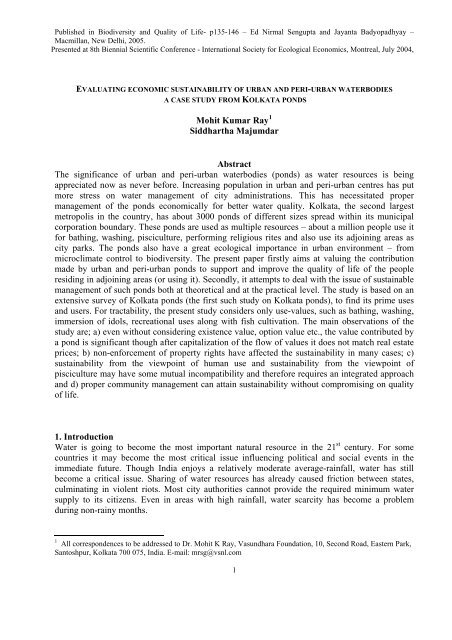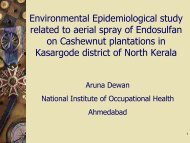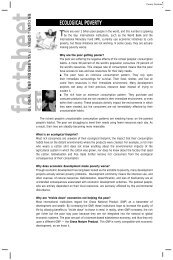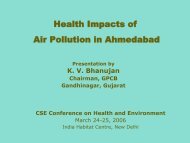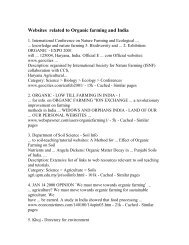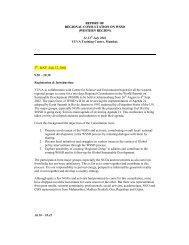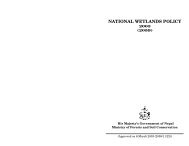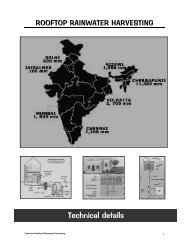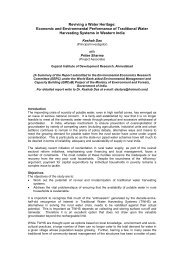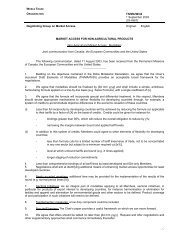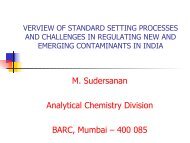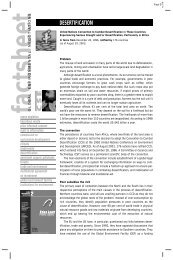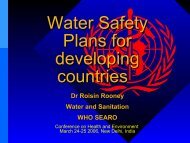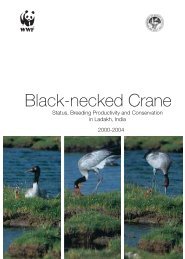Mohit Kumar Ray Siddhartha Majumdar Abstract - Rainwater ...
Mohit Kumar Ray Siddhartha Majumdar Abstract - Rainwater ...
Mohit Kumar Ray Siddhartha Majumdar Abstract - Rainwater ...
- No tags were found...
Create successful ePaper yourself
Turn your PDF publications into a flip-book with our unique Google optimized e-Paper software.
Published in Biodiversity and Quality of Life- p135-146 – Ed Nirmal Sengupta and Jayanta Badyopadhyay –Macmillan, New Delhi, 2005.Presented at 8th Biennial Scientific Conference - International Society for Ecological Economics, Montreal, July 2004,EVALUATING ECONOMIC SUSTAINABILITY OF URBAN AND PERI-URBAN WATERBODIESA CASE STUDY FROM KOLKATA PONDS<strong>Mohit</strong> <strong>Kumar</strong> <strong>Ray</strong> 1<strong>Siddhartha</strong> <strong>Majumdar</strong><strong>Abstract</strong>The significance of urban and peri-urban waterbodies (ponds) as water resources is beingappreciated now as never before. Increasing population in urban and peri-urban centres has putmore stress on water management of city administrations. This has necessitated propermanagement of the ponds economically for better water quality. Kolkata, the second largestmetropolis in the country, has about 3000 ponds of different sizes spread within its municipalcorporation boundary. These ponds are used as multiple resources – about a million people use itfor bathing, washing, pisciculture, performing religious rites and also use its adjoining areas ascity parks. The ponds also have a great ecological importance in urban environment – frommicroclimate control to biodiversity. The present paper firstly aims at valuing the contributionmade by urban and peri-urban ponds to support and improve the quality of life of the peopleresiding in adjoining areas (or using it). Secondly, it attempts to deal with the issue of sustainablemanagement of such ponds both at theoretical and at the practical level. The study is based on anextensive survey of Kolkata ponds (the first such study on Kolkata ponds), to find its prime usesand users. For tractability, the present study considers only use-values, such as bathing, washing,immersion of idols, recreational uses along with fish cultivation. The main observations of thestudy are; a) even without considering existence value, option value etc., the value contributed bya pond is significant though after capitalization of the flow of values it does not match real estateprices; b) non-enforcement of property rights have affected the sustainability in many cases; c)sustainability from the viewpoint of human use and sustainability from the viewpoint ofpisciculture may have some mutual incompatibility and therefore requires an integrated approachand d) proper community management can attain sustainability without compromising on qualityof life.1. IntroductionWater is going to become the most important natural resource in the 21 st century. For somecountries it may become the most critical issue influencing political and social events in theimmediate future. Though India enjoys a relatively moderate average-rainfall, water has stillbecome a critical issue. Sharing of water resources has already caused friction between states,culminating in violent riots. Most city authorities cannot provide the required minimum watersupply to its citizens. Even in areas with high rainfall, water scarcity has become a problemduring non-rainy months.1 All correspondences to be addressed to Dr. <strong>Mohit</strong> K <strong>Ray</strong>, Vasundhara Foundation, 10, Second Road, Eastern Park,Santoshpur, Kolkata 700 075, India. E-mail: mrsg@vsnl.com1
Published in Biodiversity and Quality of Life- p135-146 – Ed Nirmal Sengupta and Jayanta Badyopadhyay –Macmillan, New Delhi, 2005.Presented at 8th Biennial Scientific Conference - International Society for Ecological Economics, Montreal, July 2004,Water is considered as the source from where life began. Waterbodies of every form – oceans,seas, rivers, marshes or ponds –have been the niche for thousands of species of flora and fauna.Most of the living beings require water in some form for their survival. Human civilizations havealso grown depending on the water resources, as a result of which they have mostly developednear the river valleys. So water bodies have served both the cause of the conservation of nature aswell as of human development. This paper will be focussing on a specific aspect of waterresources – economic sustainability of urban and peri-urban waterbodies with special reference tothe ponds of Kolkata.The layout of the paper is as follows. In Section 2, we shall distinguish between and definevarious types of urban waterbodies like wetlands, lakes and ponds that are commonly observed inan urban area. In Section 3, we shall discuss the significance of urban waterbodies. In Section 4, abrief profile of Kolkata’s waterbodies is presented. Section 5 deals with the main observationsfrom our survey. In Section 6, we attempt to estimate the value of the flow of utility generated bya few representative ponds in our survey. Section 7 discusses the issue of environmentalmanagement and economic sustainability of urban waterbodies with special reference to twoponds selected from our survey. Finally, in Section 8, we draw our conclusions.2.Types of WaterbodiesWaterbody is a commonly used term, which may describe any place holding water. Seas, rivers,lakes, wetlands and ponds, all are waterbodies though their distinctive uniqueness as a specificform of waterbody is not always evident to all and sundry. A definition of waterbody is thereforerequired to be useful for a specific study. The waterbodies can be classified in many ways by theirsizes, locations, water quality, aquatic ecology and others. It may be artificial or natural; static orflowing, sweet or brackish, deep or shallow, permanent or temporary. Though the terms rivers andseas do not need much clarification, the terms lakes, wetlands, waterbodies, tanks or ponds arequite commonly used interchangeably.Before going into the discussion of specific urban and peri-urban waterbodies, which are the focusof this study, it may therefore be useful to define few types of waterbodies which have urban andperi-urban presence.Lakes can be described as waterbody with sufficiently large area having specific ecologicalcharacteristics. These can be sweet water lakes like Great Lakes of USA or brackish like Chilikain Orissa. Lakes can be natural or artificial. Vast man-made lakes have been built by buildingdams on rivers.However, large waterbodies are often also called lakes in the city, though much smaller than theabove-mentioned ones, mostly created for water storage, recreation and open spaces and othermajor urban requirementsWetlands have received much publicity in recent times. There has been a sustained internationaleffort for the last three decades to save wetlands mainly through the “Convention on Wetlands ofInternational Importance Especially as Waterfowl Habitats” which is commonly known asRamsar Convention after the name of the place in Iran where it was held in 1971. According tothe Ramsar Convention, wetlands are defined as," areas of marshes, fens, peat lands of water,whether natural or artificial, permanent or temporary with water, that is static or flowing, fresh,brackish or salt including the areas of marine water, the depth of which at low tide does notexceed six meter".2
Published in Biodiversity and Quality of Life- p135-146 – Ed Nirmal Sengupta and Jayanta Badyopadhyay –Macmillan, New Delhi, 2005.Presented at 8th Biennial Scientific Conference - International Society for Ecological Economics, Montreal, July 2004,The most comprehensive definition of wetlands was adopted by the scientists in the U.S Fish andWildlife Service in 1979, after several years of review. The definition is presented in a reporttitled Classification of Wetlands and Deepwater Habitats of the United States. (Cowardin et al1979)"Wetlands are lands transitional between terrestrial and aquatic systems where the water table isusually at or near the surface or the land is covered by shallow water...Wetlands must have one ormore of the following three attributes.1) At least periodically the land supports predominantly hydrophytes,2) The substrate is predominantly hydric soil and3) The substrate is non-soil and is saturated with water or covered by shallow water atsometime during the growing season of the year.”A Pond is generally described as a waterbody of a smaller size, man- made or developing it fromits natural origin. In the present study the term pond has been used as smaller waterbody in theurban and peri-urban area. The term waterbody has often been used for ponds also.3. Importance of Urban WaterbodiesIndia is fast getting urbanized. In 1991, 25.72% of Indian population lived in urban areas.Whereas the decennial population growth of the rural areas has been 19.71%, the urbanpopulation growth was as high as 36.19%, as a result of which the present urban populationconstitutes 27.8% of the total. This increase is mostly not a planned one. Urban India dependsheavily upon various types of waterbodies to meet its daily requirement of water. Therequirements fulfilled by these waterbodies, as we shall see later, do not even get reflected inurban resource accounting. Now, an increasing population implies a greater demand for water andthe pressure on these waterbodies are immense. At the same time, due to the requirement for moreland for housing and other urban expansion, the waterbodies are being filled up. So, in spite oftheir over-riding importance, the very existence of urban ponds is ‘critically endangered’.This is a highly worrying factor; for, the role of the ponds in urban and peri-urban milieu ismultifaceted. It is not only just a pool of water but has a role of social, ecological and civicimportance. The major use is no doubt bathing. A large number of people use these surface watersources for bathing, cleaning and other requirements. These people can be migrant labourers orpoor local inhabitants without any access to such civic facilities. For a large number of peopleworking in markets, small factories, living in slums or in poor housing conditions, ponds are theonly source of water for all human requirements except drinking. The major productive activityrelated to these ponds is fish cultivation. Most of these water bodies are used for pisciculture.Environmentally these waterbodies serve the purpose of an open space in the crowded urbanlocalities. Their role as controllers of microclimate needs more study. In many cases the banks ofthese waterbodies are the only spaces for development of greenery. Local natural life – aquatic,avifauna and terrestrial – sustains around these water bodies. Ponds and the surroundings are oneof the most important protectors of biodiversity.Social roles are equally important. Waterbodies have generally been associated with differentaspects of Indian cultural and religious practices. In urban places, these waterbodies also act as a3
Published in Biodiversity and Quality of Life- p135-146 – Ed Nirmal Sengupta and Jayanta Badyopadhyay –Macmillan, New Delhi, 2005.Presented at 8th Biennial Scientific Conference - International Society for Ecological Economics, Montreal, July 2004,centre of local social and cultural activities. There are clubs and temples by the side of these waterbodies. Often there is immersion of idols and fairs are organised on the fields next to thesewaterbodies. Finally, these waterbodies act as a source of water for fire fighting in the crowdedand ever-expanding urban areas.One function of ponds (which has only recently attracted the attention of environmentalists) isthat they serve as receptors for rainwater harvesting and maintaining local ground water levels.Thus urban waterbodies are a special component in water use management, to which littleattention has been paid. The inter-relation of an urban waterbody with environment, economy andsociety is presented in Table 1 below.Urban EnvironmentalComponentsWater ResourceEnvironmentTable 1Role of Ponds in Urban and Peri-Urban AreasActivitiesBathingWashing<strong>Rainwater</strong>HarvestingClimate ControlDescriptionA large number of people from lowereconomic background use them forbathingWashing of clothes, utensils andother domestic requirementsActs as rainwater storagePonds affect local micro-climate,making it cooler and soothingOpen space Ponds provide an open spaceproviding room for air movement.Space for recreational use.Trees Generally the pond banks have treeplantations, preserving urban natureAquatic Ecology Ponds support many aquatic andother species, a receptacle ofbiodiversity in urban contextEconomy Fish cultivation Source for local employment andSocialCommunityGatheringClubsgood proteinPeople spend time sitting aroundthese ponds. Many ponds have seatsaround them and are an importantplace for local community gathering.Because of open space, there oftenexist many clubs by the pond side.These clubs also manage the ponds.4
Published in Biodiversity and Quality of Life- p135-146 – Ed Nirmal Sengupta and Jayanta Badyopadhyay –Macmillan, New Delhi, 2005.Presented at 8th Biennial Scientific Conference - International Society for Ecological Economics, Montreal, July 2004,CultureSafetyTemples Many ponds have temples by theirsides. Temple authorities also mangesome ponds.Holy ponds Some ponds have a historyassociated with them and/or arerelated to some shrines and areconsidered as holy ones.Fair Due to the presence of temples, fairsare organised in the open spaces infront of many pondsImmersion Immersion of Idols is an importantevent in Hindu festivals. A numberof ponds are specifically used for thatFire Extinguishing In congested urban areas, ponds arevery useful as a source of watersupply for extinguishing fire.4. Kolkata’s WaterbodiesBackground: Kolkata, previously known as Calcutta, is the capital of the state of West Bengal ineastern India. It is the second largest metropolis in the country. It is situated on the left bank of theriver Hugli (Ganga). Kolkata is well connected with the rest of the country by roads, rail and air.Kolkata experiences a humid and hot summer but not so cold a winter. It receives moderate toheavy rainfall. Mean maximum temperature rises above 36oC and mean minimum temperaturegoes down to about 12oC. Average rainfall is 1580 mm and most of the rain falls in four monthsfrom June to September.The Kolkata Municipal Corporation area has been selected as our study area and ponds withinthis area are the focus of the present study. The total area of the Corporation now stands at 185square kilometers and consists of 141 wards. 41 wards were added in 1984 where the process ofurbanization is still in progress, as a result of which a large number of ponds still exist in thoseareas. The wards are grouped in 15 Boroughs.Socio-economic Profile: The present Kolkata population as per the 2001 census was 4.58 millionwith a population density of 24760 persons per square km. Though decadal population growthrate is only 4.1%, the decadal population growth rate in the newly added areas is 23.89%. Kolkatalike other cities of developing countries have a high share of slum population, which is about 40percent of total population. These data are important as increase in population in new areas areincreasing pressure on existing water resources and most of the users, as we shall find later, arefrom poor households.Waterbodies: Kolkata has grown up in a land of floodplain, marshes, rivers and streams.Kolkata’s waterbodies can be classified into three major groups:a) East Kolkata wetlandsb) Three major lakesc) Ponds of various sizes numbering around 30005
Published in Biodiversity and Quality of Life- p135-146 – Ed Nirmal Sengupta and Jayanta Badyopadhyay –Macmillan, New Delhi, 2005.Presented at 8th Biennial Scientific Conference - International Society for Ecological Economics, Montreal, July 2004,Kolkata also has also a number of canals in and around the city, which are not being considered inthis study. A brief description will provide an understanding of these three different types ofwaterbodies.East Kolkata Wetland: A large area of wetlands lies on the eastern fringe of the city of Kolkata.At present the total wetland area is about 3898 hectares (Mukherjee 2002). East Kolkata wetlandshave attracted attention of the environmental scientists for more than two decades because of itstwo major functions. First, these wetlands are used for pisciculture, which provides employmentto a large number of people. Second, for carrying out this pisciculture, it utilizes city sewage thustreating the city wastewater simultaneously. On 3 February 2000, east Kolkata wetlands havebeen designated as Ramsar site thus ensuring its preservation (Chattopadhyay and Mazumdar2002). A part of the wetland is now being used also for recreational purpose like boating.Lakes: Two major man- made lakes in Kolkata are Ravindra Sarovar (30 hectares of water area)in south Kolkata and Subhas Sarovar (16 hectares of water area) in east Kolkata. These two lakeswere developed as part of place for recreation, water sports and tourism. Nevertheless, these twolakes are intensely used by hundreds of people for daily bathing and washing. The other lakecalled Nature Park (60 hectares water area) is in fact a cluster of wetlands, also used forpisciculture utilizing municipal sewage water, but it has also been developed recently forrecreational activities and tourism.Ponds: Ponds are mostly of totally different nature. These are of comparatively smaller sizesvarying from 0.03 ha to few hectares. Thus ponds can be considered as the smallest unit ofwaterbodies for this discussion. Pond excavation was once a part of social and religious customs.Ponds are distinctly separate from lakes and wetlands as they are nearly all located withinresidential areas and are meant for local uses.A distinction between the ponds and wetlands in Kolkata are presented in Table 2Table 2Comparison between Wetlands and Ponds in KolkataFunctions Wetland Urban PondLocationAt the margin of human Inside Human habitationhabitationUsersA specific group of people like Different groups offishermenCommon peopleSize Covers a wide area Small but many in numbersEcological Importance Very Important Less importantWastewater Treatment Utilized for Wastewater Should not be utilizedTreatmentSocial importance Absent SignificantFlood reduction Important role Negligible roleManagement Level Regional Community6
Published in Biodiversity and Quality of Life- p135-146 – Ed Nirmal Sengupta and Jayanta Badyopadhyay –Macmillan, New Delhi, 2005.Presented at 8th Biennial Scientific Conference - International Society for Ecological Economics, Montreal, July 2004,5.0 Survey of Ponds in Kolkata- Main ObservationsAs mentioned above, urban ponds provide a number of services. Kolkata having about 3000ponds should have been a model case to find out the role of the ponds in any city. The role of cityplanning with regards to these water resources could have been a useful reference for theeconomic considerations of ponds. Unfortunately the city planners of Kolkata never thought aboutthese ponds. In the last decade, a number of documents on planning of Kolkata have beenpublished by KMDA (Kolkata Metropolitan Development Authority) and by Department ofEnvironment, Government of West Bengal, but ponds of Kolkata got no mention in them. So thefollowing studies of 25 ponds randomly selected in different parts of Kolkata may be consideredto be a starting point in understanding the multifaceted role of these urban waterbodies.There is some uncertainty as to the exact number of ponds in Kolkata. A list of KMC updated in1997 had 1786 ponds in 141 wards. The list is not complete and this was confirmed by somesample survey in the wards. The latest counting by one department of KMC as reported in mediais 3733 (Hindustan Times, 29 July, 2003). But the other departments of KMC has not agreed tothe result (Anandabazar Patrika, 20 August, 2003) However, an overall distribution of ponds canbe obtained from the available data. It shows that out of 141 wards, as many as 52 wards (whichcomprise 37 percent of the total number of wards) do not have any ponds. If we divide Kolkatainto two groups: a) 100 ‘original’ wards and b) added 41 wards, 45 percent of the first 100 wardsdo not have any pond.25 ponds selected for the study are spread over 21 wards and 12 boroughs – covering the entireKMC area. The survey was conducted by field study at each pond. At all the ponds, the number ofusers for various uses was counted between 8 am to 2 pm for one day. A number of users weresurveyed through prepared questionnaires at each pond. Besides, other relevant data about theponds were collected from the users, from the local people, from the owners or the managingorganisation, if any. The study revealed the following important information.Number of users: As already mentioned each pond was surveyed from 8AM to 2PM to find outthe actual number of users. Total number of bathers was 8604 in 25 ponds during this period. Thelowest number of bathers was 125 and the highest was 780. Total number of users, includingthose washing clothes, cleaning utensils etc was 10199.As the counting was done not for the total use period (roughly 6 am to 5 pm), the survey did notyield the exact number of users. So we assumed that the actual number of users is 25% more thanwhat was obtained from the survey. Also considering a 20 percent increase in overall use duringthe summer months, the total number of persons using the surveyed ponds per day during thesummer months would be 15299. Thus, the average number of users per pond would be 612persons (see Table 3). Assuming that around 1500 ponds (that is, less than 50% of the total) areused extensively within the Kolkata Municipal Corporation (KMC) area, the number of all kindsof users would be about 1 million. So these urban ponds serve a huge number of people andtherefore deserve to be part of urban planning and its economic study has become a necessity.7
Published in Biodiversity and Quality of Life- p135-146 – Ed Nirmal Sengupta and Jayanta Badyopadhyay –Macmillan, New Delhi, 2005.Presented at 8th Biennial Scientific Conference - International Society for Ecological Economics, Montreal, July 2004,Table 3Number of Pond Users (on a per-day basis) in 25 pondsActual number of bathers between 8 am – 2 pm in 25 ponds in 8604winterActual number of all users between 8 am – 2 pm in 25 ponds in 10199winterTotal number of users in winter throughout the day – 25 percent 12749additional users in 25 pondsTotal number of users in summer in 25 ponds – 20 percent 15299increase from the winter seasonAverage user per pond per day during summer 612Economic background of the Users:The user survey data also revealed that majority of the people (67.99%) using the ponds belong tothe lower income group (monthly income equal to or below Rs.3000). This percentage includesthe people (16.75%) who reported no income at all as they were housewives or students or elseunemployed. 23.45 percent people provided no information. If this group is excluded, thenproportion of lower income group (out of all users) will be 89 percent. So ponds in Kolkata are amajor water- resource for the lower income group people.Uses of PondsThe pond-use pattern shows that all (100%) the ponds are used for bathing. 62% of the ponds areused for washing purposes. One of the important aspects of this finding is that the pond water is amajor source for bathing water for urban poor. Bathing is considered a primary healthcare activityand thus the question of water quality gains more importance.After bathing, the next major activity in the ponds is pisciculture. 92% of the surveyed ponds areused for it. As pisciculture is related with local employment generation, this aspect, too, should bestudied carefully.Finally, it was observed that 56% of the ponds are utilised for immersion of idols.Figure 1 shows the direct use-pattern of the urban ponds.Fig 1 Direct use of Pond Use (%)12010080%6040200Bathing WashingClothesWashing Ut. Collecting Water ThrowingGarbage8
Published in Biodiversity and Quality of Life- p135-146 – Ed Nirmal Sengupta and Jayanta Badyopadhyay –Macmillan, New Delhi, 2005.Presented at 8th Biennial Scientific Conference - International Society for Ecological Economics, Montreal, July 2004,As discussed before, the pond surroundings also make significant contribution to the social,cultural and ecological environment of the urban scenario. The survey found that all the pondshave some trees around them. Nearly half (44%) of the ponds have adjacent temples, 48% havesome clubs nearby, while 36% of the ponds have decent sitting facilities around them.Figure 2 shows the indirect use of the urban ponds.120Fig 2 Indirect use of Ponds (%)10080%6040200Trees Garden Temple Club BenchesOwnership and Management of Ponds60 % of the surveyed ponds are owned by private persons. The management of the ponds arecarried out by different groups. A number of government owned ponds are looked after by thePond Committees. Private ponds are mostly looked after by the people who take them on lease forfishing. Some local clubs and religious institutions also manage some ponds. It has been seen thatthe ponds managed by the Pond Committees are relatively better. Private ponds are looked afterthe least, as these are mostly owned on lease (for fishing).Figure 3 shows the management pattern of the surveyed ponds.80706050403020100Fig 3 Pond Maintenance (%)Club Family Persons PractisingPisc.Pond CommitteeGoodBad9
Published in Biodiversity and Quality of Life- p135-146 – Ed Nirmal Sengupta and Jayanta Badyopadhyay –Macmillan, New Delhi, 2005.Presented at 8th Biennial Scientific Conference - International Society for Ecological Economics, Montreal, July 2004,6. Valuation of WaterbodiesUnfortunately the value of services rendered by such waterbodies often gets unnoticed. Asmentioned before, a pond, like many environmental assets, can be used for consumption purposesas well as an input for some productive activities. This is a typical problem faced by public goods(which environmental assets generally are). Though the ponds are not a public good in a strictsense, however, non-excludability from and partial non-rivalry of consumption make the typicalKolkata pond vulnerable to the same kind of over-exploitation and subsequent degradationproblems as are typical of common property resources. Therefore it is necessary to form anestimate of the economic value of a pond. A brief sketch of such a valuation procedure ispresented here (see Johansson, 1987). We also attempt to make a rough estimate of the economicvalue of a few representative ponds with the data generated from this survey.The economic value of environmental goods like a pond has a composite nature. We initiallyclassify it into two categories -1) use value and 2) non -use value. Use values are defined as thosebenefits that are derived from the actual use of environment. Moreover, economists have alsointroduced the concept of option value, which is the additional value placed on a natural resourceby those who want to have the possibility of using the goods and services in future. This is knownas Option–value (Munasinghe, 1993). Non-use values are also called existence values. Theargument is that people care about environmental resources not only because they confer somebenefits upon human beings, but also because they wish to maintain or improve environmentalassets out of sympathy for animal and nature or just from a moral conviction. There is thus anintrinsic value in these things (animals/nature etc), which go beyond our own self-interest (Pearceand Turner, 1990).Valuation of Kolkata Ponds:There are different methods for evaluating environmental resources. Market price valuation iscarried out based on market price data. Indirect Valuation approach considers services orbenefits obtained from natural resources that are not marketed but a reasonable assessment is doneabout their value by an indirect approach (Hanley et al, 1997). There are different methods fordoing so like Travel Cost method, Hedonic Pricing method and Substitute Goods approach.(Hanley et al, 1997). Contingent Valuation Method involves direct questioning of theconsumers to determine their willingness to pay for enjoying the facilities rather than go withoutthem.For the present study only use values have been considered for our empirical exercise. Fishcultivation, use of water by people for bathing, washing, immersion of idols, recreation uses etc.,are therefore seen as the principal uses of these ponds.Annual value of fish produced in each pond is available from the Annual Accounts of the pondcommittees. Annual value is defined as the amount obtained from fish sale or angling charges lessthe direct costs like cost of fish feed, fish spawns, netting etc.10
Published in Biodiversity and Quality of Life- p135-146 – Ed Nirmal Sengupta and Jayanta Badyopadhyay –Macmillan, New Delhi, 2005.Presented at 8th Biennial Scientific Conference - International Society for Ecological Economics, Montreal, July 2004,Human uses include bathing, cleaning and washing. Most of the people using the pond do nothave proper water supply at home. The value of this service has been calculated by consideringthe KMC’s recent proposed water supply cost in the following way: For households of lowestvaluation grade, the proposal is Rs.30 per month. Considering 6 persons per household, itbecomes Rs.5 per person per month. Considering bathing consumes 30 percent of the water, costof each person bathing in pond is Rs. 1.50 per month. For other uses the cost is considered Rs.4.50 per person per month.This valuation does not consider the quality of water, which is also an important criterion for thenumber of people using a waterbody. For well-maintained ponds, the number of users is high.Some Pond Committees charge a fee for immersion of idols.Another important service provided by many ponds is the recreational value. Recreational valuecan be calculated by Travel Cost method It may be noted that KMC has proposed a charge formorning walkers in Ravindra Sarovar and for some other parks also. In line with that, a charge ofRs. 20 per person per month for morning walkers and Rs.10 per person per month for eveningusers can be taken as a proxy for calculating recreational value. Though it may be mentioned thatthese values will increase much in coming years.Some of the services cannot be valued or would be difficult to value. The service or benefits thatare not valued for this study are increase in property value for well maintained pond,improvement of environmental quality of the area, overall aesthetic improvement, option-values,intrinsic – values.Considering these valuations, annual valuation of flow of utility is presented in Table 4 andTable 5.Table 4Annual Valuation of Flow of Utility from a Representative PondService Basis of valuation Total AnnualValuationRs.Recreational Value: Considering 30morning walkers and 50 evening usersUse of Water: Considering 516 bathersand 96 other usersRs.20/- per morning-walkerand Rs.10/- per evening-userper month13200.00Rs. 1.50 per month for bathers 13320.00and Rs. 4.50 for other usersTotal 26520.0011
Published in Biodiversity and Quality of Life- p135-146 – Ed Nirmal Sengupta and Jayanta Badyopadhyay –Macmillan, New Delhi, 2005.Presented at 8th Biennial Scientific Conference - International Society for Ecological Economics, Montreal, July 2004,Table 5Annual Fish Production in 4 Ponds (Audited Figures, 2001)Service Basis of valuation Total AnnualValuationRs.Sale of fish and Angling rent i) Angling: Rs.135650/- Rs. 200720/-ii) Sale of Fish:Rs.137702/-iii)Direct Cost: Rs. 72632/-It shows that average value of fish sale from a pond is Rs. 68338. Though the quantity of fishproduction depends much on the size of the pond, yet considering this for an average pond andconsidering 1500 ponds producing fish, the yearly value of fish produced in Kolkata ponds wouldbe Rs. 102.5 million. This figure can be taken to as an indicative value to understand theeconomic importance of these urban waterbodies.7.0 Environmental Management and Economic SustainabilityTo understand the impact of environmental management of urban ponds let us now consider twoexamples. Two ponds which were selected for survey, one (Pond A) was solely used for fishcultivation to generate fund and other pond (Pond B) was well maintained for environmentalquality. The two ponds are of similar sizes. Table 6 and Table 7 provide the annual value ofutility flow for these two ponds.Table 6Annual Valuation of Flow of Utility Pond A (Environmentally unmanaged)Service Basis of valuation Total AnnualValuationRs.Fish Sale: Here fish cultivation is doneby renting out to the anglers and directfish catchUse of Water: Considering 261 bathersand 65 other usersAngling: Rs. 1.35,650.00Sale of fish: Rs. 22,988.00Direct expenses: Rs.56543.00(Source: Annual Audit Report2001)93283.00Rs. 1.50 per month for bathers 8208.00and Rs. 4.50 for other usersTotal 101491.00Thus the Pond A generates an annual flow of utility valued at Rs.101491.12
Published in Biodiversity and Quality of Life- p135-146 – Ed Nirmal Sengupta and Jayanta Badyopadhyay –Macmillan, New Delhi, 2005.Presented at 8th Biennial Scientific Conference - International Society for Ecological Economics, Montreal, July 2004,Table 7Annual Valuation of Flow of Utility of Pond B (Environmentally managed)Service Basis of valuation Total AnnualValuationRs.Fish Sale: Here fish is harvested by directcatch (and not by renting out to anglers)Sale of fish: Rs.70,480.00Direct Exp: Rs.38,101.00(Source: Annual AuditReport 2001)32379.00Use of Water: Considering 861 bathers Rs. 1.50 per month for 12915.00bathersCharges for Idol Immersion: Charges for (Source: Annual Audit 23921.00immersion of idol depends on size of idol Report 2001)Sale of idol’s frame Rs. 3100.00 3100.00Recreational Value: Considering 50morning walkers and 70 evening usersRs. 20 per month & Rs.10 20400.00per month respectivelyTotal 92715.00Therefore, the Pond B generates an annual flow of utility worth Rs.92715.The above case studies can be useful to understand the role of environmental management forurban and peri-urban ponds. It can be seen that the difference in total annual valuation of theutility generated by the two ponds is not very significant since a yearly fluctuation of 20 percentfrom sale of fish is normal. But, there are significant differences between the type of earnings ofthe two ponds and the services provided. Value generated from the use of water (bathing etc.)consists only 8.1 % of total valuation for the Pond A while in case of the Pond B, the value ofservice generated from use of water and recreation consists of 35.9 % of total valuation. Due tobetter water quality, the number of bathers is 3 times higher in the well-managed pond. It has beenalso found that fish cultivation and human uses have opposing water quality requirements. Thus,there is a trade-off between pisciculture and human uses in respect of use of a pond.If the values of ecological improvement, aesthetics and increase in property value are considered,the overall valuation will be much more in case of a well-managed pond.Sustainable development is defined as development that takes care of present developmentwithout jeopardizing the interest of future generation. As the waterbodies in the urban areas havea number of roles to play, they need to be sustained. To sustain the ponds for carrying outmaintenance and development, fund is required which can be obtained from proper utilization ofthe pond. The above results show that the ponds could make a reasonable profit from fishcultivation. However, the ponds can also generate significant revenue from by better13
Published in Biodiversity and Quality of Life- p135-146 – Ed Nirmal Sengupta and Jayanta Badyopadhyay –Macmillan, New Delhi, 2005.Presented at 8th Biennial Scientific Conference - International Society for Ecological Economics, Montreal, July 2004,environmental management, and utilizing the pond as a consumable resource. In fact, theimportant public service of providing water resource to at least a million people is going onwithout any subsidy from government.Our studies found that privately owned or leased-out ponds are not environmentally managedproperly and they are in general the worst victims of degradation. In contrast, ponds managed bycommunity groups, which can enforce some sort of property rights, are utilized better, are subjectto less degradation, and in general, generate surpluses that can be used for environmentalsustenance.8.0 ConclusionIt may be concluded from the above analysis that:i) Urban and peri-urban ponds are the main sources of water for a large number ofpeople. For Kolkata, the figure is likely to be at least a million.ii) Most of the users come from the poorer section of the society.iii) The value generated by the ponds is quite significant, even though option-value,iv)existence-value etc. have not been considered.Since providing water to its citizens is a basic duty of the State, the Municipalauthorities/Government have a moral responsibility to ensure that the ponds areproperly managed/ not degraded. In this context, it may be noted that the cost saved bythe authorities in not having to provide water to a million more people could haveprovided the right basis for our valuation exercise, had the data been available. Thatwould have considerably enhanced the valuation.v) Sustainability from the viewpoint of human use and that from the viewpoint ofpisciculture may have some mutual incompatibility and therefore requires anintegrated approach.vi)ReferencesNon-enforcement of property rights affects sustainability, while proper communitymanagement can attain a reasonable degree of sustainability without compromising onthe quality of life.1. Chattopadhyay, Kunal and Krishna Mazumdar (2002) “Economics of EnvironmentalDegradation – East Kolkata Wetlands”, in Kunal Chattopadhyay and Krishna Mazumdar(eds), Kolkata-- the City of Wetlands, Dept. of Fisheries, Government of West Bengal. Pp1742. Cowardin, L.M., V. Carter, F.C Golet and E.T.LaRoe (1979), Classification of Wetlandsand Deepwater Habitats of the United States, U.S. Fish & Wildlife Service Publication, -quoted in Wetlands by W.J.Mitsch and J.G.Gosselink, Van Nostrand Reinhold Company,New York, 19863. Hanley, N., J.Shogren and B.White (1997), Environmental Economics, Macmillan IndiaLtd., New Delhi.4. Hindustan Times, 29 July 2003.5. Johansson, P.O. (1987) The Economic Theory and Measurement of EnvironmentalBenefits, Cambridge University Press, Cambridge.6. Mukherjee, Madhumita & D.K Maity, (2002) East Kolkata Wetland – Policy Option forSustainable Development, in Kunal Chattopadhyay and Krishna Mazumdar (eds), Kolkata-- the City of Wetlands, Dept. of Fisheries, Government of West Bengal, pp 2.14
Published in Biodiversity and Quality of Life- p135-146 – Ed Nirmal Sengupta and Jayanta Badyopadhyay –Macmillan, New Delhi, 2005.Presented at 8th Biennial Scientific Conference - International Society for Ecological Economics, Montreal, July 2004,7. Munasinghe, M. (1993) “Environmental Economics and Sustainable Development’ WorldBank Environment Paper Number 3, World Bank, Washington, D.C8. Pearce, D.W., and R.K. Turner (1990) Economics of Natural Resources and Environment,Harvester Wheatsheaf, New York.----------------0000000---------------15


